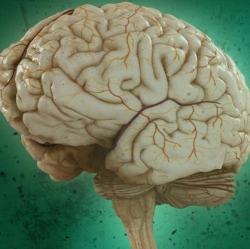
Imagine having the technology to help patients with physical impairments retrain their minds to recover motor skills. A new study demonstrates that a brain computer interface could be a feasible way to achieve that goal, by exploiting a little-known loophole in how our brains control our muscle movements.
The common understanding is that the opposite side of your brain controls your body’s motor functions. Put simply: The left hemisphere of the brain fires when you make a fist with your right hand. But a growing body of research indicates that this isn’t the full story.
“One of the things that we discovered back in 2008 was that there was a physiology associated with same sided limb movement,” Eric Leuthardt, professor at Washington University and co-senior author of the paper, told Gizmodo. Back then, researchers revealed that when you decide to move your right arm, the process actually begins in the right hemisphere of your brain, and is then picked up by the opposite side to perform the movement.
Paralysis on one side of the body is a common symptom of a stroke. One hemisphere of the brain is too damaged to issue the limb movement commands, but stroke patients don’t lose the will to move their limbs. If patient with a hand paralyzed due to a stroke is asked to make a fist, they still want to, and can still imagine making that fist.
“They just can’t move it. So, we know that there’s something in their mind, still present,” said Leuthardt.
To leverage this still-operating drive to move their bodies, the research team created a device called the Ipsihand that used a head cap to pick up a faint brain signal in the unharmed side of the brain. It then sends commands to a computer, which is hooked up to a wearable exoskeleton. This exoskeleton then can move the thumb, index and middle fingers of the paralyzed stroke patient so they regain a little bit of grasping ability. In trials, after using the Ipsihand, every involved part of a patient’s body began to improve, and it all came down to timing.
“Firing together leads to wiring together,” said Leuthardt. When the nerves fire in the brain at the same time as the hand responds due to the exoskeleton, those actions build new physical connections and links in the still-unharmed brain hemisphere.
In the most recent study, ten patients who were partially paralyzed due to a stroke saw a meaningful improvement in their quality of life. Over the course of 12 weeks, these patients used the Ipsihand device for ten minutes to two hours a day, gaining back the ability to manipulate blocks to form a tower, and to move their hands to their mouths.
Even more encouraging, this study was done in the patients’ homes, by themselves. Although a commercial product is still a while away, it also has potential to be used in other neuropsychiatric diseases.
“I think this is an early and simple example of kind of this approach,” said Leuthardt. He’s particularly encouraged because the treatment doesn’t use drugs or surgery.
“It’s using that person’s thoughts to induce changes in the brain that heals them,” he said. “That’s a really profound thing that tells us that we know that our minds matter in our recovery.”
